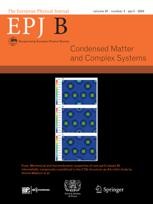How did the COVID pandemic end so abruptly?
New analysis suggests that a dramatic drop in deaths from COVID-19 between 2022 and 2023 could be attributed to an abrupt phase transition in the molecular structure of the virus’ spike protein.
New York | Heidelberg, 21 August 2024
 During the winter of 2020 and 2021, the US saw deaths from COVID-19 reach 250,000. The following year, this number surged by a third to 330,000. But from August 2022 to March 2023, the number of deaths related to COVID-19 deaths plummeted to just 80,000, abruptly ending the COVID pandemic. This dramatic decline couldn’t be attributed solely to vaccines, which had been already widely available since Spring 2021.
During the winter of 2020 and 2021, the US saw deaths from COVID-19 reach 250,000. The following year, this number surged by a third to 330,000. But from August 2022 to March 2023, the number of deaths related to COVID-19 deaths plummeted to just 80,000, abruptly ending the COVID pandemic. This dramatic decline couldn’t be attributed solely to vaccines, which had been already widely available since Spring 2021.
Through new research published in EPJ B Marcelo Moret of CIMATEC in Brazil, together with James Phillips at Rutgers University, New Jersey, suggest that a phase transition in the molecular structure of the COVID-19 spike protein made the virus less likely to cause severe infections. Their results offer important insights into how the pandemic ended so quickly, and could help us to prepare for future pandemics.
The spike protein protrudes from the surfaces of viruses like COVID-19, and facilitates entry into host cells by binding to specific receptors on cell membranes. As the virus mutates, these proteins can change rapidly: improving the virus's ability to bind to receptors, but in some cases, making it less deadly.
In their study, Moret and Phillips examined the link between mutations and death rates. They discovered that a phase transition in the spike protein’s molecular structure - comparable to transitions between phases of matter in physics - could be directly responsible for the sudden drop in fatalities. This phase transition occurred in new strains of the Omicron variant which emerged in 2023, which featured just 5 additional mutations from the original Omicron variant.
The duo’s study suggests that this transition altered the virus's binding mechanisms in the upper respiratory tract - the passages connecting the nose, mouth, and throat - making severe infections less likely. This insight not only enhances our understanding of COVID-19’s evolving contagiousness but also offers valuable lessons for preparing for future pandemics. Through future research, Moret and Phillips hope to further solidify these theories, providing deeper insights into how future pandemics may evolve.
Reference: Moret, M.A., Phillips, J.C. Why and how did the COVID pandemic end abruptly? Eur. Phys. J. B 97:123 (2024). https://doi.org/10.1140/epjb/s10051-024-00733-0
Further Information
For more information visit: www.epj.org
Services for Journalists
The full-text article is available here.
Contact
Sabine Lehr | Springer | Physics Editorial Department
tel +49-6221-487-8336 | sabine.lehr@springer.com
